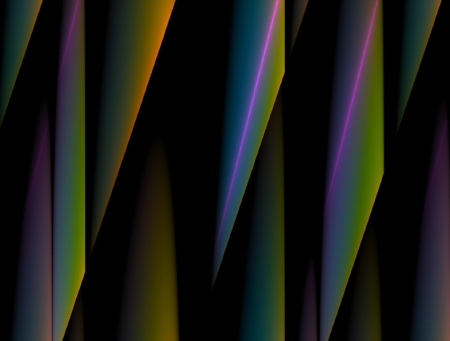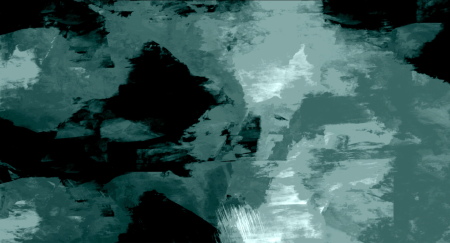Today will be the screening of a film programme I put together for the Australian Cinematheque at the Queensland Art Gallery in Brisbane, Australia. It is a part of a much larger series of screenings on visual music there, curated by Cindy Keefer of the Center for Visual Music in Los Angeles. In it I show a number of works I’ve included in earlier programmes, but there’s two new films I was very happy to include. “Loudthings” by Telcosystems had its premiere at the Rotterdam Film Festival last year and it marks a very interesting new phase in their work: again a step away from their earlier more geometric and pixelbased work towards more organic or otherwise spontaneous forms of organization. In contrast the new film by Bart Vegter, called “De Tijd” (“Time”) for me marks a return to the geometrical clarity of his earlier films, while integrating the more fluid character of his software-based work of the last 15 years.

still from “De Tijd” by Bart Vegter.
Soundfields from The Netherlands
– Telcosystems “Sessions_03_rev03 – SH” (video, 2006, 4 min.)
– Martijn van Boven “Interfield” (video, 2007, 7 min.)
– Bas van Koolwijk, Gert-Jan Prins “Synchronator” (video, 2006, 6 min.)
– Marcel Wierckx “Black Noise White Silence” (video, 2006, 3 min.)
– Bart Vegter “De Tijd” (35mm, 2008, 9 min.)
– Telcosystems “LOUDTHINGS” (35mm, 2008, 13 min.)
– Joost Rekveld “#11, Marey <-> Moiré” (35mm scope, 1999, 21 min.)
total 63 min
– Telcosystems “Sessions_03_rev03 – SH” (video, 2006, 4 min.)
Sessions_03_rev03 is the third revision of the third episode in the ‘Sessions’ series. It is a compilation of footage from the live shows by Telcosystems, collected and recorded over a period of three years. The footage has been created while performing live with their own generative software for sound and image. The shows were performed using three powerbook laptops and one projectionscreen + stereo soundsystem.
– Martijn van Boven “Interfield” (video, 2007, 7 min.)
“Interfield is a description of a imaginary universe, made visible via abstract imagery and a electronic drone. The work ‘Interfield’ refers to a position of the audience from where they perceive an environment which they are not part of. From this position they experience how both audio and image are gradually unfolding into an autonomous composition scheme. Until a point is reached where both are colliding into a synchronomous point in time. Starting from this point on they continue in a mild symbiosis, to develop endlessly in time.”
– Bas van Koolwijk, Gert-Jan Prins “Synchronator” (video, 2006, 6 min.)
Since the early years of video art, works have been made which do not actually produce a standard TV signal waveform and therefore cannot be directly recorded. Some are based primarily upon magnetic distortion of the normal TV scan pattern, others utilise a Cathode Ray Tube as if it were an oscilloscope screen.
“Synchronator” is a video and audio research project by Gert-Jan Prins and Bas van Koolwijk in an attempt to use a combination of current digital and analogue means in order to make more use of the characteristic visual qualities of such techniques. This first video to come out of the project demonstrates the audio modulations of a video signal, which were produced by means of an audio mixer. Bas van Koolwijk concentrates mainly on digital experiments, while Gert-Jan Prins mostly works with analogue techniques. They both carry out research into the relationship between sound and image, as well as the limits of what is audible and visible.
– Marcel Wierckx “Black Noise White Silence” (video, 2006, 3 min.)
“The tight synchronization of video and audio is the dominant source of tension in this piece – the visual activity is mapped explicitly pixel-per-pixel to the audio track, resulting in an intense multi-sensoral experience for the viewer. It was inspired by the experimental video works of computer graphics pioneers such as Lillian Schwartz and John Whitney. The use of fractal-generated source material gives this work an organic quality, while its compact form provides a sense of immediacy and contiguity.
Black Noise White Silence was conceived and created as a pure representation of music as digital data. The digital medium has rapidly dominated the way in which we not only create music, but especially in how music is consumed. Because of this, digital representations of sound are now nearly always the stage between the composer and the realization of a composition, as well as the step between the realized composition and its consumption by an audience.
One of the implications of working in the digital domain is the extent to which computing power can be harnessed to extend creative possibilities. Black Noise White Silence was generated through the use of algorithms conceived by the composer and which were performed by a machine in real-time. The composer guided and influenced the algorithms during the creative process; his role lay in between the deterministic and spontaneous (or intuitive?) decision making processes.”
– Bart Vegter “De Tijd” (35mm, 2008, 9 min.)
For almost thirty years now, Bart Vegter has been making abstract animations. His first four films were exquisitly minimal geometric compositions made using a variety of traditional animation techniques. The last fifteen years bart Vegter has been making his film on the computer, writing his own software to explore the worlds of pattern hidden in complex mathematical algorithms. These patterns often evoke natural phenomena like the shapes of sand dunes or the weather. His most recent film “De Tijd” (“Time”) marks a return to a more geometrical world of forms.
“A monochrome flat image changes slowly into a theatrical spectacle in which colour subtly melts and solidifies lines and conical forms. At the end, the colours lose their power and all that is left is the basic structure of the image, ‘the skeleton’.”

still from “LOUDTHINGS” by Telcosystems.
– Telcosystems “LOUDTHINGS” (35mm, 2008, 13 min.)
“An audiovisual travelogue of an expedition to the inside of the computer.
With the aid of a set of elementary instructions, a self running network of algorithmic processes is programmed to produce spatial images and sound. The result is a non-referential world making an intense appeal to the eye and the ear; a reconnaissance of the boundaries of human perception.”
– Joost Rekveld “#11, Marey <-> Moiré” (35mm scope, 1999, 21 min.)
#11, Marey <-> Moiré is an abstract composition of light and sound in which the mechanics and optics of cinema are not the means but the end. Images are generated using long stroboscopic exposures, resulting in a neo primitive kind of op-art. A tribute to the scientists who laid the foundations for the film medium.
